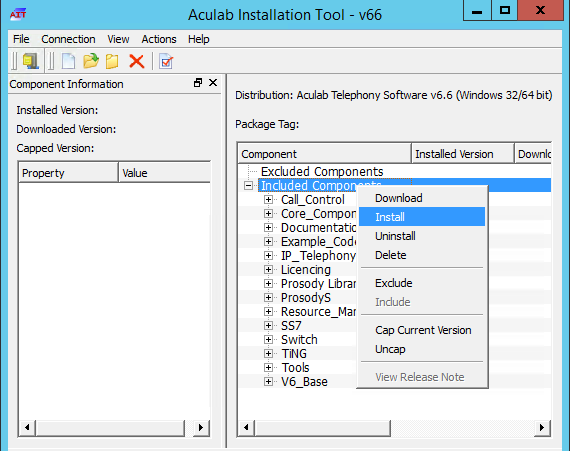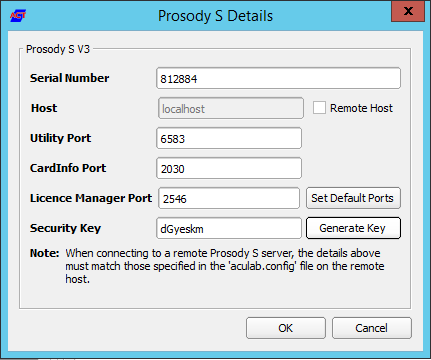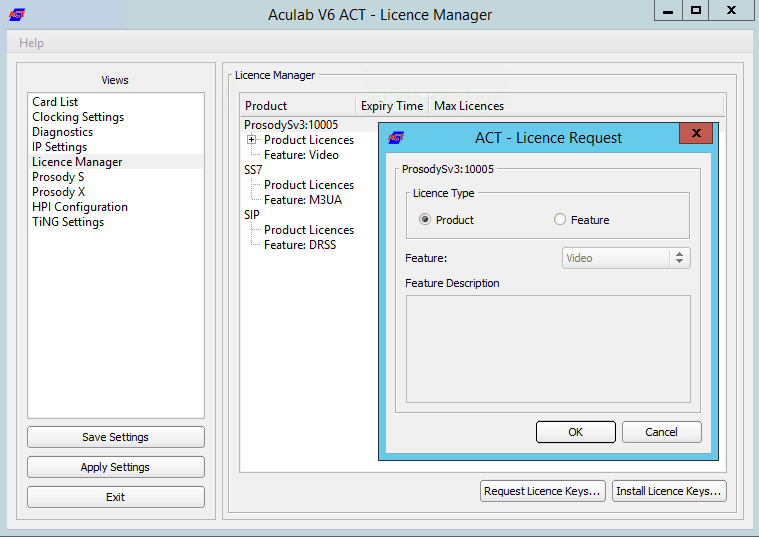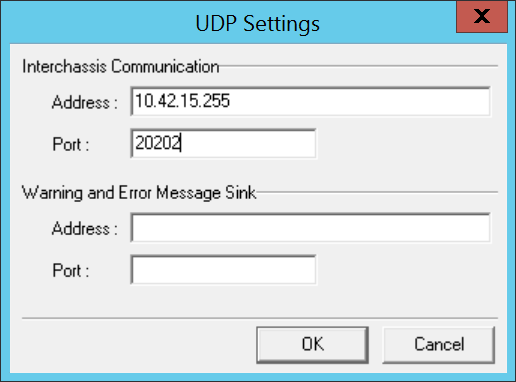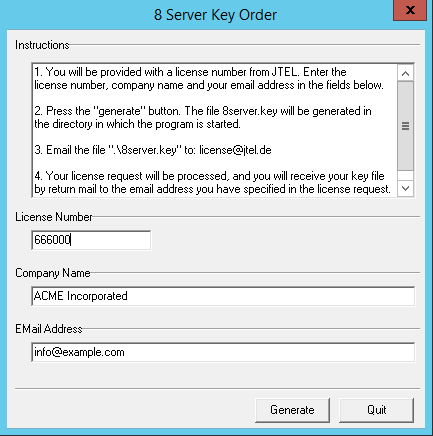| Sv translation | ||||||||||||||||||||||||||||||||||||||||||||||||||||||||||||||||||||||||||||||||||||||||||||||||||||||||||||
|---|---|---|---|---|---|---|---|---|---|---|---|---|---|---|---|---|---|---|---|---|---|---|---|---|---|---|---|---|---|---|---|---|---|---|---|---|---|---|---|---|---|---|---|---|---|---|---|---|---|---|---|---|---|---|---|---|---|---|---|---|---|---|---|---|---|---|---|---|---|---|---|---|---|---|---|---|---|---|---|---|---|---|---|---|---|---|---|---|---|---|---|---|---|---|---|---|---|---|---|---|---|---|---|---|---|---|---|---|
| ||||||||||||||||||||||||||||||||||||||||||||||||||||||||||||||||||||||||||||||||||||||||||||||||||||||||||||
IntroductionThe TEL server runs the call flows for telephone calls in the jtel system. It also runs background processes, such as jobs to create statistics subscription e-mails and convert audio files or create audio with a TTS engine. Also, usually PBX connectors are run on the TEL server. InstallationFile DownloadsThe following script downloads all the files needed in this section.
Configure Data SourcesImport the downloaded file odbc_ini_v52.reg to the registry to configure the data sources in windows. You may need to change the password entries for each datasource, depending on the password configured for the mysql database. Prepare 8-Server RegistryImport the downloaded file 8server_config_v8.reg to the registry to prepare the registry for 8-Server. You will need to change the Machine ID setting - set this to the last byte of the IPv4 address in the local network. You need to change this value to HEX. Install 8-ServerClone Repository
Run the following commands from a non elevated command prompt:
Install 8-ServerTelephony and DeamonsRun the following commands from a non elevated command prompt:
Deamons OnlyRun the following commands from a non elevated command prompt:
Windows FirewallThe following commands configure the windows firewall. Run these in an elevated cmd window:
Install Aculab SIP and RTP StackInstall AITRun the following commands from a non elevated command prompt, and install for all users:
Install Aculab v67
Configure Aculab
Symmetric RTPTo configure symmetric RTP, a file is created in
Port RangeIf it is required, that a port range is used for RTP, then the file C:\aculab\v67\cfg\aculab.config must be edited, set the port range as is required by the remote end (PBX / SIP Trunk):
Services
Setup the following Aculab services to start only manually:
Setup the following Aculab services to be disabled:
Startup ScriptsNet UseCheck the file c:\8Server\bin\startup.cmd - to see whether the net use command needs to be changed or not.
ShortcutCreate a shortcut for: c:\8Server\bin\startup_launcher.cmd and place this in shell:startup. Configuration FilesCreate Default Configuration giAculab.cfgStart a cmd up, and start gihal. This will create a default giAculab.cfg file.
Edit giAculab.cfgThe file is in: c:\8Server\gi2\config\giAculab.cfg giAculab.cfg is now configured for SIP with 8-Server. Replace the SIP section in the newly created file with the section below, changing the following:
Edit gi2.iniEdit the file At the very bottom, change the following setting to 2 (standard is 1):
Edit StdCall_MCP.cfg
The following settings are changed in the file: c:\8Server\config\StdCall_MCP.cfg
8-Server ConfigurationStartup 8-Server:
ConfigurationMachine ID (Settings ... General)Set to the last byte of the IPv4 address of the machine. Internet ComponentsIncrease the number of UDP components, but only on machines which have a lot of lines. Recommend: up to 200 lines use 40. Above 200 lines, increase by 20 for every additional 100 lines. UDP SettingsIf building a cluster with more than one 8-Server, enter the broadcast address for interchassis communication, using port 20202:
|
| Translations Ignore | ||
|---|---|---|
|
The following list is for a pure telephony server (daemon applications are running on a separate server):
| Translations Ignore | |||||
|---|---|---|---|---|---|
|
The following list is for a pure daemon application server:
| Translations Ignore | |||||
|---|---|---|---|---|---|
|
Stop 8-Server
Now shutdown 8-Server using File ... Exit.
8-Server License
Use C:\8Server\bin\KeyOrder6.exe to request a license for 8-Server:
Send the file C:\8Server\bin\8server.key to support@jtel.de
Once the license file is received, delete the file:
C:\8Server\bin\8server.key
and place the license file in:
C:\8Server\Config
Install the Platform UDP Listener
Installation
Install the platform UDP listener with the following commands:
| Translations Ignore | |||||
|---|---|---|---|---|---|
|
Shortcut
Create a shortcut from:
c:\PlatformUDPListener\startListener.bat
and place this in shell:startup
Test
Start the platform UDP listener. It should find other cluster members, for example the webserver or database master, if other machines are already active.
Windows Autostart
To enable all applications to startup automatically (unless they are installed as services), an automatic login should be configured on windows.
Unpack AutoLogin.zip, and run the executable.
Setup the required account details, and save.
Reboot the machine to test! Note - give the machine a couple of minutes since if you attach via RDP to the account running the jtel applications, you will cause a login to occur and the applications to be started.
| Sv translation | ||||||
|---|---|---|---|---|---|---|
| ||||||
|
| Sv translation | ||||||||||||||||||||||||||||||||||||||||||||||||||||||||||||||||||||||||||||||||||||||||||||||||||||||||||||
|---|---|---|---|---|---|---|---|---|---|---|---|---|---|---|---|---|---|---|---|---|---|---|---|---|---|---|---|---|---|---|---|---|---|---|---|---|---|---|---|---|---|---|---|---|---|---|---|---|---|---|---|---|---|---|---|---|---|---|---|---|---|---|---|---|---|---|---|---|---|---|---|---|---|---|---|---|---|---|---|---|---|---|---|---|---|---|---|---|---|---|---|---|---|---|---|---|---|---|---|---|---|---|---|---|---|---|---|---|
| ||||||||||||||||||||||||||||||||||||||||||||||||||||||||||||||||||||||||||||||||||||||||||||||||||||||||||||
IntroductionLe serveur TEL gère les flux d'appels pour les appels téléphoniques dans le système jtel. Il exécute également des processus en arrière-plan, tels que des emplois pour créer des e-mails d'abonnement aux statistiques et convertir des fichiers audio ou créer des fichiers audio avec un moteur TTS. En outre, les connecteurs PBX sont généralement exécutés sur le serveur TEL. InstallationTéléchargement de fichiersLe script suivant permet de télécharger tous les fichiers nécessaires dans cette section.
Configurer les ressources donnéesImporter le fichier téléchargé odbc_ini_v52.reg au registre pour configurer les sources de données dans windows. Vous devrez peut-être modifier les entrées du mot de passe pour chaque source de données, en fonction du mot de passe configuré pour la base de données mysql. Préparer un registre de 8-ServerImporter le fichier téléchargé 8server_config_v8.reg au registre pour préparer le registre pour 8-Server. Vous devrez modifier le ID Machine setting - régler ce paramètre sur le dernier octet de l'adresse IPv4 dans le réseau local. Vous devez changer cette valeur en HEX. Installer 8-Servercloner le dépôt
Exécutez les commandes suivantes à partir d'un invite de commande non élevé:
Installer 8-ServerTéléphonie et DémonsExécutez les commandes suivantes à partir d'un invite de commande non élevé:
Uniquement DémonsExécutez les commandes suivantes à partir d'un invite de commande non élevé:
Pare-feu WindowsLes commandes suivantes permettent de configurer le pare-feu Windows. Exécutez-les dans un cmd windows élevé:
Installer Aculab SIP et RTP StackInstaller AITExécutez les commandes suivantes à partir d'un invite de commande non élevéet l'installer pour tous les utilisateurs :
Installer Aculab v67
Configurer Aculab
RTP SymétriquePour configurer le RTP symétrique, un fichier est créé dans
Plage PortS'il est nécessaire qu'une plage de ports soit utilisée pour le RTP, alors le fichier C:\aculab\v67\cfg\aculab.config doit être édité, définissez la plage de ports requise par l'extrémité distante (PBX / SIP Trunk) :
Services
Configurez les services Aculab suivants pour qu'ils ne démarrent que manuellement :
Configurez les services Aculab suivants pour qu'ils soient handicapés :
Scripts de démarrageUtilisation du netVérifiez the fichier c:\8Server\bin\startup.cmd - pour voir si la commande d'utilisation du net doit être modifiée ou non.
RaccourciCréer un raccourci pour : c:\8Server\bin\startup_launcher.cmd et le placer dans shell:startup. Fichiers de configurationCréer une configuration par défaut giAculab.cfgDémarrez un cmd up, et commencez gihal. Cela créera un défaut fichier giAculab.cfg.
Modifier giAculab.cfgLe dossier est en cours : c:\8Server\gi2\config\giAculab.cfg giAculab.cfg est maintenant configuré pour SIP avec 8-Server. Remplacez la section SIP dans le fichier nouvellement créé par la section ci-dessous, en modifiant ce qui suit :
Modifier gi2.iniModifier le fichier Tout en bas, changez le paramètre suivant pour 2 (la norme est 1) :
Modifier StdCall_MCP.cfg
Les paramètres suivants sont modifiés dans le fichier : c:\8Server\config\StdCall_MCP.cfg
Configuration 8-ServerDémarrage 8-Server:
ConfigurationID Machine (Paramètres ... Général)Réglé sur le dernier octet de l'adresse IPv4 de la machine. Composantes de l'InternetAugmenter le nombre de composants UDP, mais seulement sur les machines qui ont beaucoup de lignes. Recommandation : jusqu'à 200 lignes, il faut en utiliser 40. Au-delà de 200 lignes, augmentez de 20 pour chaque 100 lignes supplémentaires. Paramètres UDPSi vous construisez un cluster avec plus d'un 8-serveur, entrez l'adresse de diffusion pour la communication interchâssis, en utilisant le port 20202 :
|
| Translations Ignore | ||
|---|---|---|
|
La liste suivante concerne un serveur de téléphonie pure (les applications des démons fonctionnent sur un serveur séparé) :
| Translations Ignore | |||||
|---|---|---|---|---|---|
|
La liste suivante concerne un serveur d'application purement démoniaque :
| Translations Ignore | |||||
|---|---|---|---|---|---|
|
Stop 8-Server
Fermez maintenant le 8-Server en utilisant le fichier ... Sortez.
Licence 8-Server
Utilisez C:\8Server\bin\KeyOrder6.exe pour demander une licence pour le 8-Server :
Envoyer le fichier C:\8Server\bin\8server.key ausupport@jtel.de
Envoyer le fichier Une fois le fichier de licence reçu, supprimez le fichier :
C:\8Server\bin\8server.key
et placer le fichier de licence dans:
C:\8Server\Config
Installation de la plate-forme UDP Listener
Installation
Installez la plate-forme UDP listener avec les commandes suivantes :
| Translations Ignore | |||||
|---|---|---|---|---|---|
|
Raccourci
Créer un raccourci de:
c:\PlatformUDPListener\startListener.bat
et le placer dans shell:startup.
Test
Démarrez l'auditeur de la plateforme UDP. Il devrait trouver d'autres membres du cluster, par exemple le serveur web ou le maître de la base de données, si d'autres machines sont déjà actives.
Démarrage automatique de Windows
Pour permettre à toutes les applications de démarrer automatiquement (sauf si elles sont installées en tant que services), une connexion automatique doit être configurée sur Windows.
Décompressez AutoLogin.zip, et lancez l'exécutable.
Définissez les détails du compte requis et enregistrez.
Redémarrez la machine pour la tester ! Note - donnez quelques minutes à la machine car si vous vous connectez via RDP au compte qui exécute les applications jtel, vous provoquerez une connexion et les applications seront lancées.
